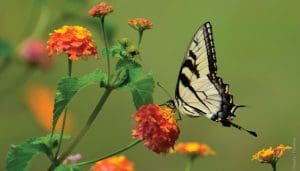Observing Pollinators
Pollinators are animals that assist plants in their reproductive cycles and are critical to the world’s food supply. Pollinators include ants, bats, bees, birds, butterflies and more. In recent years, their populations have suffered severe declines, especially among honey bee colonies.
The Great Sunflower Project engages volunteers to help scientists understand and respond to changes in pollinator populations and the types of flowering plants that pollinators prefer from wherever they are. You can observe pollinators on any plant. It doesn’t have to be a sunflower.
Simply observe any flowering plant for 5-15 minutes, count and identify the pollinators that visit the plant, then log your data online. There are two ways to upload your observations to the project, via smartphone (enter data right from the field) or data sheets (record data on paper sheets included in the kit, then enter the data via a tablet or computer later).
Check out the kit
Check out the kit for free with your library card. You can see if the kit is available in the catalog, and if it's checked out, place a hold to get on the waiting list.
Kits check out for 3 weeks.


About this Kit

In this kit
Stopwatch
Binoculars
4 Guides (in English only)
Arizona Trees and Wildflowers
Bees and other pollinators
Arizona butterflies and pollinators
Sibley’s backyard birds of the desert southwest
Data sheet pad (Spanish and English)
Survey (Spanish and English)
How to help scientists collect data using your smartphone or tablet
STEP 1
Register at the Great Sunflower Project’s website.
Adjust the binoculars before you head out.
• Fold the binoculars until they are comfortable for both eyes.
• Close your right eye and rotate the center adjusting knob until you can see clearly through your left eye.
• Close your left eye and open your right eye, turn the right eyepiece ring (diopter) until you can see clearly. The image should now be clear in both eyes.
STEP 2
Bring your kit with you outside and find a good spot to observe flowering plants. You will want to observe your selected plant for at least five minutes, so get comfortable. Look over the pollinator and plant guides.
Focus on one site or plant each time you engage in this project to help you better understand your local pollinator community.
STEP 3
From your smart device and The Great Sunflower Project website, click on Add a Count to record your observations.
Set the stopwatch for the amount of time (5 – 15 minutes) and write down the types of pollinators that visit and the number of visits they make during the time. If the same pollinator flies away and comes back, count it twice. Remember, you are counting the visits.
If possible, record the type of pollinator. The pollinator field guides can help you identify specific pollinators.
STEP 4
Check the picture on the top of the kit and make sure all the items are there before you return it to the library.
Please fill out the survey inside the kit to let us know if you liked it.
Thank you for your participation!
OPTIONAL: PLANT SUNFLOWER SEEDS
Sunflowers are great for pollinators. Planting sunflowers or other flowering plants in helps keep pollinators healthy and are perfect for future pollinator observations. Check to see if the Seed Library has any sunflower seeds in stock.
Don't have a smartphone or tablet?
You can use a library computer to participate in this project.
STEP 1
Adjust the binoculars before you head out.
• Fold the binoculars until they are comfortable for both eyes.
• Close your right eye and rotate the center adjusting knob until you can see clearly through your left eye.
• Close your left eye and open your right eye, turn the right eyepiece ring (diopter) until you can see clearly. The image should now be clear in both eyes.
STEP 2
Bring your kit with you outside and find a good spot to observe flowering plants. You will want to observe your selected plant for at least five minutes, so get comfortable. Look over the pollinator and plant guides.
Focus on one site or plant each time you engage in this project to help you better understand your local pollinator community.
STEP 3
On the data entry form, record the date, time and location of the flowering plant you selected. Enter the type of plant you’re observing and the approximate number of flowers on that plant.
Set the stopwatch for the amount of time (5 – 15 minutes) and write down the types of pollinators that visit and the number of visits they make during the time. If the same pollinator flies away and comes back, count it twice. Remember, you are counting the visits.
If possible, record the type of pollinator. The pollinator field guides can help you identify specific pollinators.
STEP 4
When you are ready to add the data to the website, register at the Great Sunflower Project’s website.
Then click “Add A Count” and just add your data from the printed sheet to the online data form. You can make as many observations as you would like over time.
If possible, record the type of pollinator. You can be as specific as you want, but please be specific only if you are certain! The pollinator field guides can help you identify specific pollinators.
STEP 5
Check the picture on the top of the kit and make sure all the items are there before you return it to the library.
Please fill out the survey inside the kit to let us know if you liked it.
Thank you for your participation!
OPTIONAL: PLANT SUNFLOWER SEEDS
Sunflowers are great for pollinators. Planting sunflowers or other flowering plants in helps keep pollinators healthy and are perfect for future pollinator observations. Check to see if the Seed Library has any sunflower seeds in stock.

